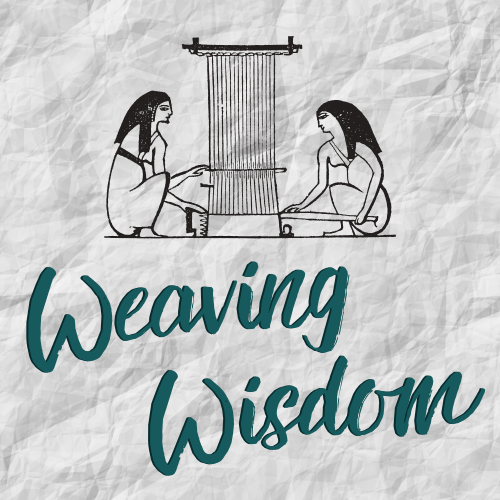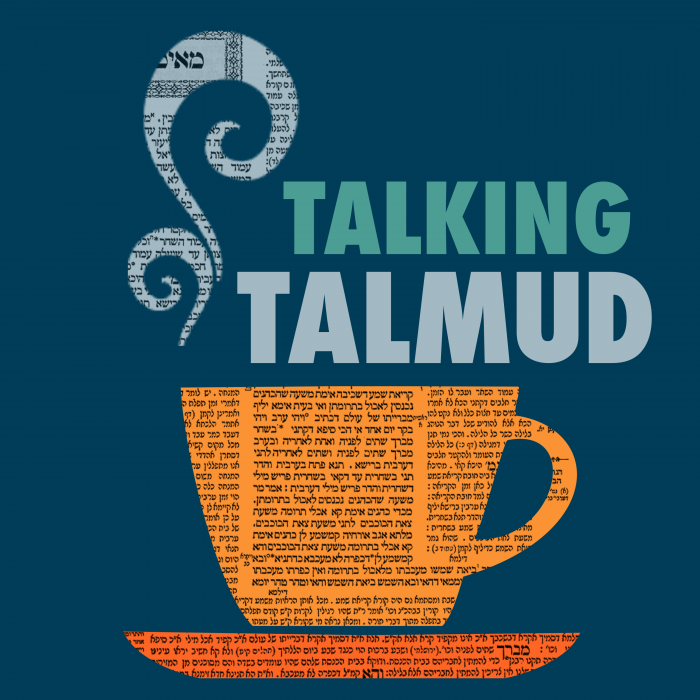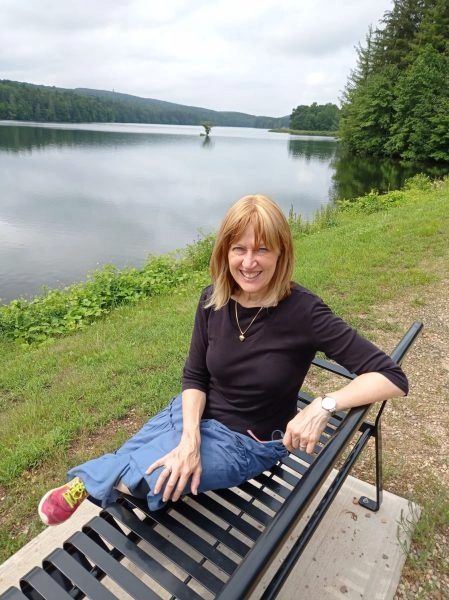Shabbat 95
כּוֹחֶלֶת — מִשּׁוּם צוֹבַעַת, גּוֹדֶלֶת וּפוֹקֶסֶת — מִשּׁוּם בּוֹנָה. וְכִי דֶרֶךְ בִּנְיָן בְּכָךְ? אִין, כִּדְדָרֵשׁ רַבִּי שִׁמְעוֹן בֶּן מְנַסְיָא: ״וַיִּבֶן ה׳ אֱלֹהִים אֶת הַצֵּלָע״, מְלַמֵּד שֶׁקִּילְּעָהּ הַקָּדוֹשׁ בָּרוּךְ הוּא לְחַוָּה וֶהֱבִיאָהּ אֵצֶל אָדָם — שֶׁכֵּן בִּכְרַכֵּי הַיָּם קוֹרִין לְקַלָּעִיתָא ״בַּנָּיְתָא״. תַּנְיָא, רַבִּי שִׁמְעוֹן בֶּן אֶלְעָזָר אוֹמֵר: גּוֹדֶלֶת כּוֹחֶלֶת וּפוֹקֶסֶת, לְעַצְמָהּ — פְּטוּרָה, לַחֲבֶרְתָּהּ — חַיֶּיבֶת. וְכֵן הָיָה רַבִּי שִׁמְעוֹן בֶּן אֶלְעָזָר אוֹמֵר מִשּׁוּם רַבִּי אֱלִיעֶזֶר: אִשָּׁה לֹא תַּעֲבִיר סְרָק עַל פָּנֶיהָ מִפְּנֵי שֶׁצּוֹבַעַת.
A woman who applies eye shadow is liable due to dyeing; one who braids her hair and applies blush is liable due to the prohibition against building. The Gemara asks about this: And is that the typical manner of building? The Gemara answers: Yes, braiding one’s hair is considered building, as Rabbi Shimon ben Menasya taught that the verse states: “And the Lord God built the side that He took from Adam into a woman” (Genesis 2:22), which teaches that the Holy One, Blessed be He, braided Eve’s hair and brought her to Adam. From where is it derived that this is the meaning of built? It is because in the islands of the sea they call braiding building. It was taught in a baraita that Rabbi Shimon ben Elazar says: With regard to a woman who braids her hair and who applies eye shadow or blush on Shabbat, if she did it for herself, she is exempt; if she did it for another, she is liable. This is because a woman cannot perform these actions for herself in as complete a fashion as she can for someone else. And, so too, Rabbi Shimon ben Elazar would say in the name of Rabbi Eliezer: A woman may not apply rouge to her face on Shabbat because by doing so she is dyeing, which is one of the prohibited labors on Shabbat.
תָּנוּ רַבָּנַן: הַחוֹלֵב וְהַמְחַבֵּץ וְהַמְגַבֵּן — כִּגְרוֹגֶרֶת. הַמְכַבֵּד, וְהַמְרַבֵּץ, וְהָרוֹדֶה חַלּוֹת דְּבַשׁ, שָׁגַג בְּשַׁבָּת — חַיָּיב חַטָּאת, הֵזִיד בְּיוֹם טוֹב — לוֹקֶה אַרְבָּעִים, דִּבְרֵי רַבִּי אֱלִיעֶזֶר. וַחֲכָמִים אוֹמְרִים: אֶחָד זֶה וְאֶחָד זֶה אֵינוֹ אֶלָּא מִשּׁוּם שְׁבוּת.
The Sages taught in a baraita: One who milks an animal, and one who sets milk to curdle, and one who makes cheese, in the measure of a dried fig-bulk, and one who sweeps the house, and one who sprinkles water on the floor, and one who removes honeycombs, if he did so unwittingly on Shabbat, he is liable to bring a sin-offering. If he did so intentionally on a Festival, he receives forty lashes; this is the statement of Rabbi Eliezer. And the Rabbis say: Both this, on Shabbat and that, on a Festival, these actions are only prohibited due to a rabbinic decree, not by Torah law. Therefore, one is neither liable to bring a sin-offering nor to receive lashes for performing those actions.
רַב נַחְמָן בַּר גּוּרְיָא אִיקְּלַע לִנְהַרְדָּעָא. בְּעוֹ מִינֵּיהּ: חוֹלֵב, מִשּׁוּם מַאי מִיחַיַּיב? אֲמַר לְהוּ: מִשּׁוּם חוֹלֵב. מְחַבֵּץ, מִשּׁוּם מַאי מִיחַיַּיב? אֲמַר לְהוּ: מִשּׁוּם מְחַבֵּץ. מְגַבֵּן, מִשּׁוּם מַאי חַיָּיב? אֲמַר לְהוּ: מִשּׁוּם מְגַבֵּן. אֲמַרוּ לֵיהּ: רַבָּךְ קָטֵיל קְנֵי בְּאַגְמָא הֲוָה. אֲתָא שְׁאֵיל בֵּי מִדְרְשָׁא. אֲמַרוּ לֵיהּ: חוֹלֵב חַיָּיב — מִשּׁוּם מְפָרֵק. מְחַבֵּץ חַיָּיב — מִשּׁוּם בּוֹרֵר, מְגַבֵּן חַיָּיב — מִשּׁוּם בּוֹנֶה.
The Gemara relates: Rav Naḥman bar Gurya happened to come to Neharde’a. The students asked him: For what prohibited labor is one who milks liable? He said to them: For milking. For what prohibited labor is one who sets milk to curdle liable? He said to them: For setting milk to curdle. For what is a person who makes cheese liable? He said to them: For making cheese. They said to him: Your teacher was a reed cutter in a swamp who did not know how to explain the mishna to his students. He came and asked those questions in the study hall. They said to him: One who milks is liable for performing the prohibited labor of extracting, which is a subcategory of threshing, on Shabbat. This is because when one extracts milk from a cow it is similar to the act of threshing, where one removes the desired content from its covering. One who sets milk is liable for the prohibited labor of selecting because part of the milk is separated and made into congealed milk. And one who makes cheese is liable for building because the cheese within the milk assumes a solid form, which is similar to the process of building.
הַמְכַבֵּד, הַמְרַבֵּץ, וְהָרוֹדֶה חַלּוֹת דְּבַשׁ, שָׁגַג בְּשַׁבָּת — חַיָּיב חַטָּאת, הֵזִיד בְּיוֹם טוֹב — לוֹקֶה אַרְבָּעִים, דִּבְרֵי רַבִּי אֱלִיעֶזֶר. אָמַר רַבִּי אֶלְעָזָר: מַאי טַעְמָא דְּרַבִּי אֱלִיעֶזֶר — דִּכְתִיב: ״וַיִּטְבֹּל אוֹתָהּ בְּיַעְרַת הַדְּבָשׁ״, וְכִי מָה עִנְיַן יַעַר אֵצֶל דְּבַשׁ? אֶלָּא לוֹמַר לָךְ: מָה יַעַר, הַתּוֹלֵשׁ מִמֶּנּוּ בְּשַׁבָּת — חַיָּיב חַטָּאת, אַף חַלּוֹת דְּבַשׁ, הָרוֹדֶה מִמֶּנּוּ בְּשַׁבָּת — חַיָּיב חַטָּאת.
The baraita cited above taught: With regard to one who sweeps the house, and one who sprinkles water on the floor, and one who removes honeycombs, if he did so unwittingly on Shabbat, he is liable to bring a sin-offering. If he did so intentionally on a Festival, he receives forty lashes; this is the statement of Rabbi Eliezer. Rabbi Elazar said: What is the rationale for the statement of Rabbi Eliezer? His rationale is as it is written: “And he put forth the end of the rod that was in his hand and dipped it in the honeycomb [yarat hadevash]” (i Samuel 14:27). The Gemara wonders: What does a forest [ya’ar] have to do with honey [devash]? Rather, it comes to tell you: Just as with regard to a forest, one who picks from a tree on Shabbat is liable to bring a sin-offering, so too, with regard to a honeycomb, one who removes honey from it on Shabbat is liable to bring a sin-offering.
אַמֵּימָר שְׁרָא זִילְחָא בְּמָחוֹזָא. אָמַר: טַעְמָא מַאי אֲמוּר רַבָּנַן — דִּילְמָא אָתֵי לְאַשְׁוֹיֵי גּוּמּוֹת, הָכָא לֵיכָּא גּוּמּוֹת. רָבָא תּוֹסְפָאָה אַשְׁכְּחֵיהּ לְרָבִינָא דְּקָא מִצְטַעַר מֵהַבְלָא, וְאָמְרִי לַהּ מָר קַשִּׁישָׁא בְּרֵיהּ דְּרָבָא אַשְׁכְּחֵיהּ לָרַב אָשֵׁי דְּקָא מִצְטַעַר מֵהַבְלָא, אֲמַר לֵיהּ: לָא סָבַר לַהּ מָר לְהָא דְּתַנְיָא: הָרוֹצֶה לְרַבֵּץ אֶת בֵּיתוֹ בְּשַׁבָּת, מֵבִיא עֲרֵיבָה מְלֵאָה מַיִם וְרוֹחֵץ פָּנָיו בְּזָוִית זוֹ, יָדָיו בְּזָוִית זוֹ, רַגְלָיו בְּזָוִית זוֹ, וְנִמְצָא הַבַּיִת מִתְרַבֵּץ מֵאֵלָיו? אֲמַר לֵיהּ: לָאו אַדַּעְתַּאי.
The Gemara relates: Ameimar permitted sprinkling water in the city of Meḥoza. He said: What is the reason that the Rabbis said it is prohibited to sprinkle water? It was due to concern lest one come to smooth out holes in an unpaved floor. Here, in Meḥoza, there are no holes in the floor because all the houses have stone floors. The Gemara also relates: Rava Tosfa’a, an expert on the Tosefta, found that Ravina was suffering on Shabbat from the dusty hot air in the house. And some say that Mar Kashisha, son of Rava, found that Rav Ashi was suffering from the dusty hot air. Mar Kashisha said to Rav Ashi: And does my Master not hold in accordance with this halakha that was taught in a baraita: One who wishes to sprinkle water on the floor of his house on Shabbat, where it is otherwise prohibited, brings a large basin full of water, and washes his face in this corner, then moves the basin and washes his hands in this corner, his feet in this corner, and it will eventuate that the floor of the entire house is sprinkled by itself from the water that splashed in a backhanded manner? Rav Ashi said to him: It did not enter my mind to employ that method.
תָּנָא: אִשָּׁה חֲכָמָה מְרַבֶּצֶת בֵּיתָהּ בְּשַׁבָּת. וְהָאִידָּנָא דִּסְבִירָא לַן כְּרַבִּי שִׁמְעוֹן, שְׁרֵי אֲפִילּוּ לְכַתְּחִלָּה.
One of the Sages taught: A wise woman sprinkles water on the floor of her house on Shabbat by washing different vessels in different parts of the house. And now that we hold in accordance with the opinion of Rabbi Shimon, who maintains that it is permitted to perform an unintentional act on Shabbat, it is permitted to sweep and sprinkle water on the floor of a house on Shabbat even ab initio, because one’s intention is not to smooth the holes in the floor.
מַתְנִי׳ הַתּוֹלֵשׁ מֵעָצִיץ נָקוּב — חַיָּיב, וְשֶׁאֵינוֹ נָקוּב — פָּטוּר. וְרַבִּי שִׁמְעוֹן פּוֹטֵר בָּזֶה וּבָזֶה.
MISHNA: One who severs a leaf or a fruit from a plant growing in a perforated flowerpot on Shabbat is liable, as a plant in a flowerpot with holes in it has the legal status of a plant connected to the ground. Picking from it is prohibited due to reaping. And one who picks from an imperforated pot is exempt, but it is prohibited to do so ab initio. And Rabbi Shimon deems one who does so exempt in both this, the case of the perforated flowerpot, and that, the case of the imperforated flowerpot.
גְּמָ׳ רָמֵי לֵיהּ אַבָּיֵי לְרָבָא, וְאָמְרִי לַהּ רַבִּי חִיָּיא בַּר רַב לְרַב: תְּנַן רַבִּי שִׁמְעוֹן פּוֹטֵר בָּזֶה וּבָזֶה. אַלְמָא נָקוּב לְרַבִּי שִׁמְעוֹן — כְּשֶׁאֵינוֹ נָקוּב מְשַׁוֵּי לֵיהּ. וּרְמִינְהוּ, רַבִּי שִׁמְעוֹן אוֹמֵר: אֵין בֵּין נָקוּב לְשֶׁאֵינוֹ נָקוּב
GEMARA: Abaye raised a contradiction before Rava, and some say it was Rabbi Ḥiyya bar Rav who raised the contradiction before Rav: On the one hand, we learned in the mishna that Rabbi Shimon deems one exempt in both this case and that case. Apparently, Rabbi Shimon equates a perforated pot with an imperforated pot. And they raised a contradiction: Rabbi Shimon says: The only difference between a perforated pot and an imperforated pot
אֶלָּא לְהַכְשִׁיר זְרָעִים בִּלְבַד! אֲמַר לֵיהּ: לְכׇל מִילֵּי רַבִּי שִׁמְעוֹן כְּתָלוּשׁ מְשַׁוֵּי לֵיהּ, וְשָׁאנֵי לְעִנְיַן טוּמְאָה, דְּהַתּוֹרָה רִיבְּתָה טׇהֳרָה אֵצֶל זְרָעִים, שֶׁנֶּאֱמַר: ״עַל כׇּל זֶרַע זֵרוּעַ אֲשֶׁר יִזָּרֵעַ״.
is with regard to rendering seeds capable of becoming ritually impure. Seeds that are in a perforated pot have the legal status of seeds planted in the ground and, as such, cannot become ritually impure. Seeds that are in an imperforated pot are considered detached from the ground and can become ritually impure. Apparently, in other areas of halakha, Rabbi Shimon holds that a plant in a perforated pot has the legal status of a plant in the ground (Me’iri). He said to him: With regard to all matters of halakha, Rabbi Shimon equates the status of a perforated pot with that of being detached. However, the matter of impurity is different, as the Torah amplified purity with regard to seeds, as it is stated: “And if anything falls from their carcasses upon any sowing seed that is sown, it is pure” (Leviticus 11:37). The repetitive language: “Any sowing seed that is sown” teaches that any seed that can be characterized as sowing, including one growing in a perforated pot, remains pure. However, in other areas of halakha, the status of a perforated pot is equal to that of an imperforated pot.
בְּעָא מִינֵּיהּ הָהוּא סָבָא מֵרַבִּי זֵירָא: שׁוֹרֶשׁ כְּנֶגֶד נֶקֶב מַה לִּי אָמַר רַבִּי שִׁמְעוֹן? אִישְׁתִּיק וְלָא אֲמַר לֵיהּ וְלָא מִידֵּי. זִימְנָא חֲדָא אַשְׁכְּחֵיהּ דְּיָתֵיב וְקָאָמַר: וּמוֹדֶה רַבִּי שִׁמְעוֹן שֶׁאִם נִיקַּב בִּכְדֵי טׇהֳרָתוֹ. אֲמַר לֵיהּ: הַשְׁתָּא שׁוֹרֶשׁ כְּנֶגֶד נֶקֶב בְּעַאי מִינָּךְ וְלָא אֲמַרְתְּ לִי וְלָא מִידֵּי, נִיקַּב בִּכְדֵי טׇהֳרָתוֹ מִיבַּעְיָא?!
A certain Elder raised a dilemma before Rabbi Zeira: In a case where the root of a plant in a perforated pot is opposite the hole, what would Rabbi Shimon say in terms of whether or not it is considered attached to the ground? He was silent and did not say anything to him. The Gemara relates that once the same Elder found Rabbi Zeira, who was sitting and saying: And Rabbi Shimon agrees that if the hole in the flowerpot is large enough to render it ritually pure, i.e., unable to hold olives, it is considered attached to the earth with regard to Shabbat. He said to him: Now, I raised a dilemma before you as to Rabbi Shimon’s ruling in a case where the root is opposite the hole, and you did not say anything to me. With regard to a case where the root is not actually opposite the hole, but its hole is large enough to render it pure, do you need to tell me that the dilemma whether or not it is considered detached is unresolved? Rather, this must certainly be understood differently.
אָמַר אַבָּיֵי: וְאִי אִיתְּמַר לְהָא דְּרַבִּי זֵירָא, הָכִי הוּא דְּאִיתְּמַר: וּמוֹדֶה רַבִּי שִׁמְעוֹן שֶׁאִם נִיקַּב לְמַטָּה מֵרְבִיעִית.
Abaye said: And if the statement of Rabbi Zeira that Rabbi Shimon holds that a perforated pot is considered attached to the ground, was stated, it was stated as follows: And Rabbi Shimon agrees that if the pot was perforated below the level where it could hold a quarter of a log, it is no longer considered a vessel, and the plants are considered attached to the ground.
אָמַר רָבָא, חָמֵשׁ מִדּוֹת בִּכְלֵי חֶרֶס: נִיקַּב כְּמוֹצִיא מַשְׁקֶה — טָהוֹר מִלְּטַמֵּא גִּיסְטְרָא וַעֲדַיִין כְּלִי הוּא לְקַדֵּשׁ בּוֹ מֵי חַטָּאת; נִיקַּב כְּכוֹנֵס מַשְׁקֶה — טָהוֹר מִלְּקַדֵּשׁ בּוֹ מֵי חַטָּאת וַעֲדַיִין כְּלִי הוּא לְהַכְשִׁיר בּוֹ זְרָעִים; נִיקַּב כְּשׁוֹרֶשׁ קָטָן — טָהוֹר מִלְּהַכְשִׁיר בּוֹ זְרָעִים וַעֲדַיִין כְּלִי הוּא לְקַבֵּל בּוֹ זֵיתִים; נִיקַּב כְּמוֹצִיא זֵיתִים — טָהוֹר מִלְּקַבֵּל בּוֹ זֵיתִים וַעֲדַיִין כְּלִי הוּא לְקַבֵּל בּוֹ רִימּוֹנִים; נִיקַּב כְּמוֹצִיא רִימּוֹנִים — טָהוֹר מִכְּלוּם. וְאִם הוּקַּף צָמִיד פָּתִיל — עַד שֶׁיִּפָּחֵת רוּבּוֹ.
Apropos the purification of an earthenware vessel, the Gemara cites that Rava said: Five measures were stated with regard to holes in an earthenware vessel: If it was perforated with a small hole from which liquid seeps, it is no longer a vessel and is ritually pure in terms of the impurity of a shard. Certain shards of impure earthenware vessels remain impure if they can still be used. If it has a hole, even a small one that liquids can flow through, it can no longer transmit ritual impurity. However, it remains a complete vessel in which to sanctify the purification waters of the red heifer, which require a whole vessel. And if it was perforated with a hole large enough to enable liquid to enter the vessel, it is ritually pure in terms of sanctifying the purification waters in it, but it remains a vessel in terms of rendering seeds in it capable of becoming ritually impure. And if it was perforated with a hole the size of a small root, it is ritually pure in terms of rendering seeds in it capable of becoming ritually impure, but it remains a vessel that can become ritually impure in terms of holding olives. And if it was perforated with a hole large enough to enable olives to go out, it is pure in terms of the impurity of all other vessels that can hold olives, but it remains a vessel in terms of holding pomegranates. If the vessel is designated for use in holding pomegranates, it can become ritually impure because it is suitable for that use. If it was perforated with a hole large enough to enable pomegranates to go out, it is ritually pure from any type of impurity. And if the mouth of an earthenware vessel that is in a room with a corpse is surrounded by a sealed cover, it does not become ritually pure, even if its hole was large enough to enable a pomegranate to go out. It protects whatever is inside the vessel from contracting impurity, unless the majority of the vessel is broken.
אָמַר רַב אַסִּי: שָׁמַעְתִּי כְּלִי חֶרֶס שִׁיעוּרוֹ כְּמוֹצִיא רִימּוֹן. אֲמַר לֵיהּ רָבָא: שֶׁמָּא לֹא שָׁמַעְתָּ אֶלָּא בְּמוּקָּף צְמִיד פָּתִיל. וְהָא רָבָא הוּא דְּאָמַר מוּקָּף צְמִיד פָּתִיל עַד שֶׁיִּפָּחֵת רוּבּוֹ! לָא קַשְׁיָא,
Rav Asi said: I heard that with regard to an earthenware vessel, the measure of the hole that renders it unable to become ritually impure is large enough to enable a pomegranate to go out. Rava said to him: Perhaps you only heard this when its mouth is surrounded by a sealed cover, but an ordinary earthenware vessel becomes ritually pure with a hole big enough to enable an olive to go out. The Gemara asks: Isn’t Rava himself the one who said that an earthenware vessel that is surrounded by a sealed cover protects whatever is inside the vessel from contracting impurity unless the majority of the vessel is broken? The Gemara answers: This is not difficult.























